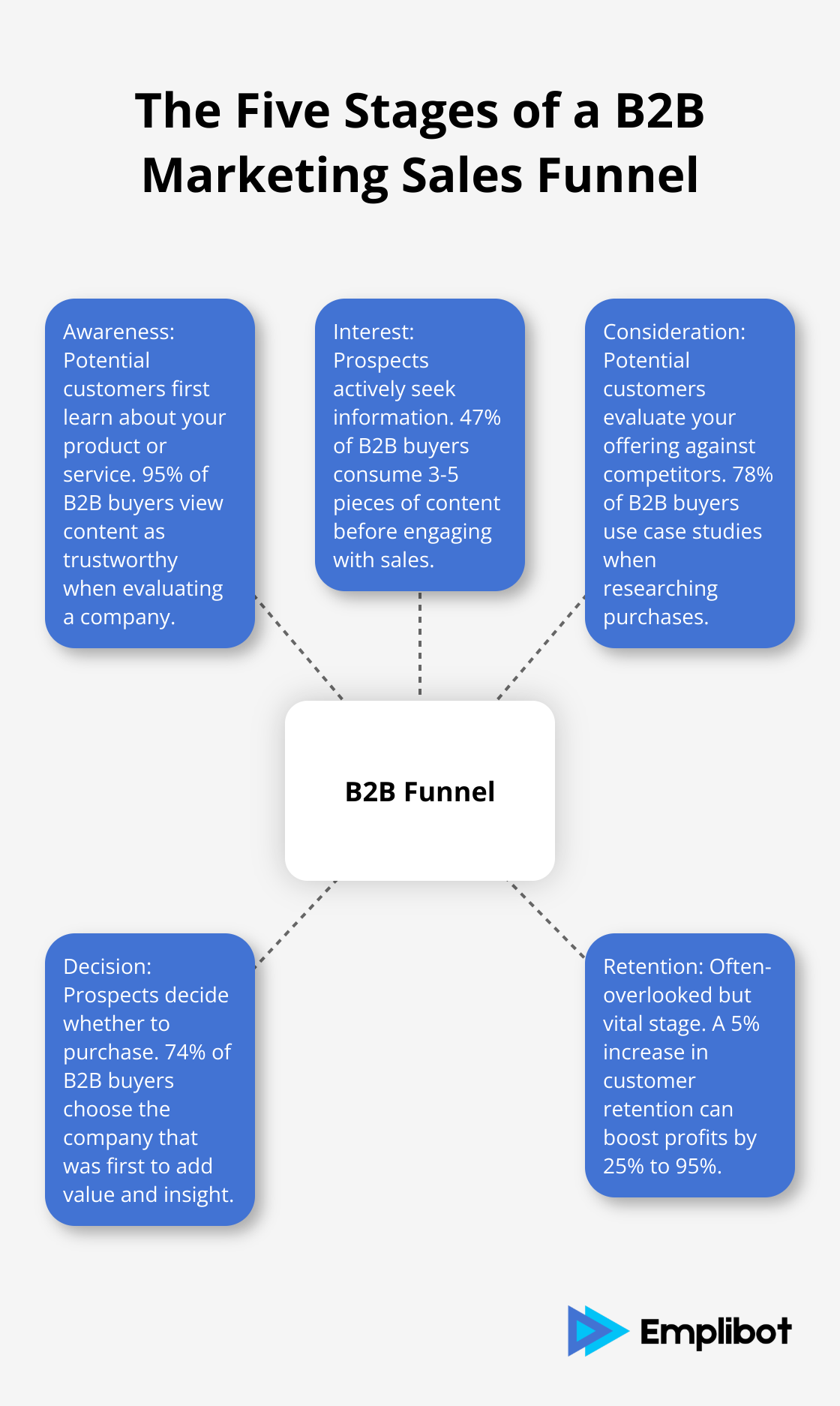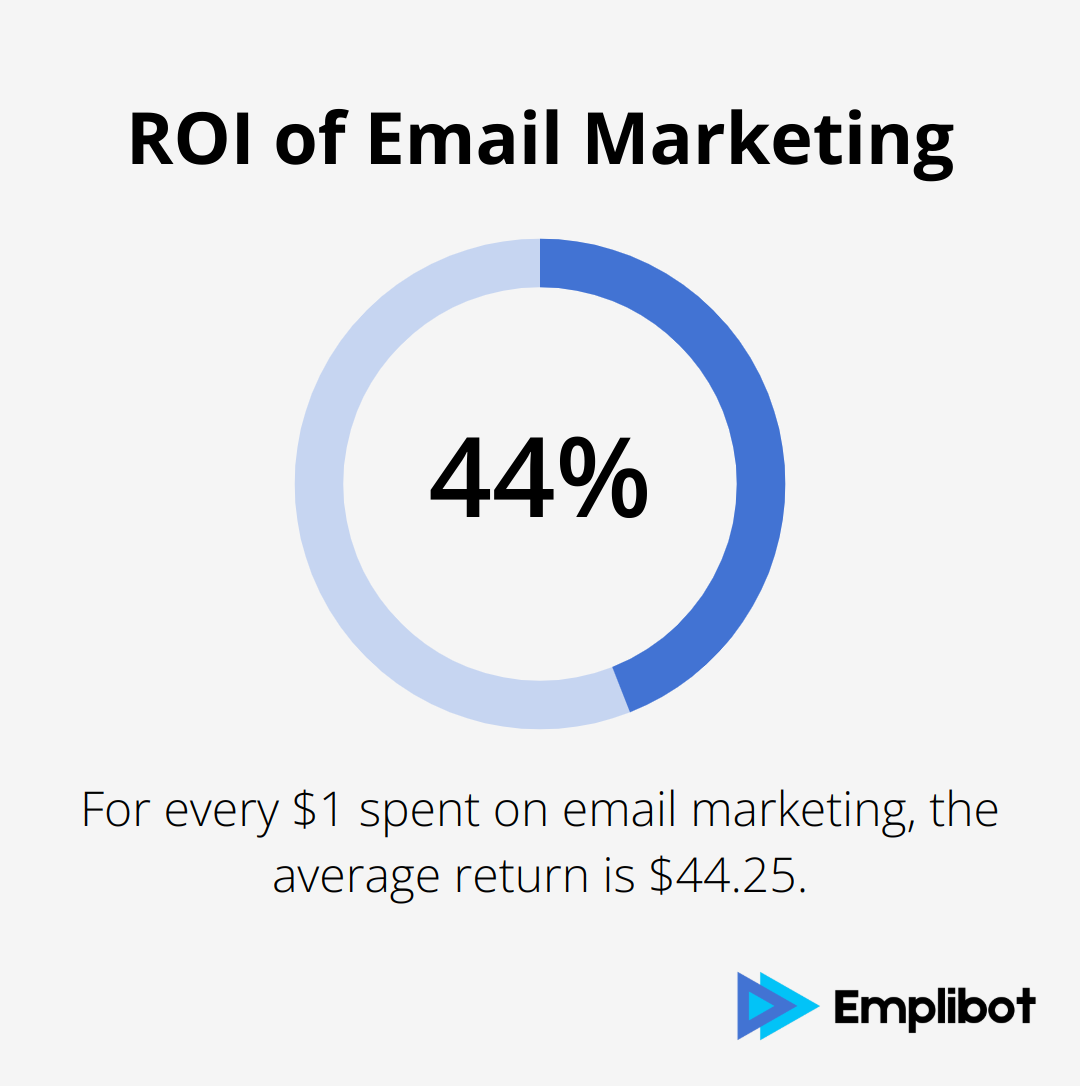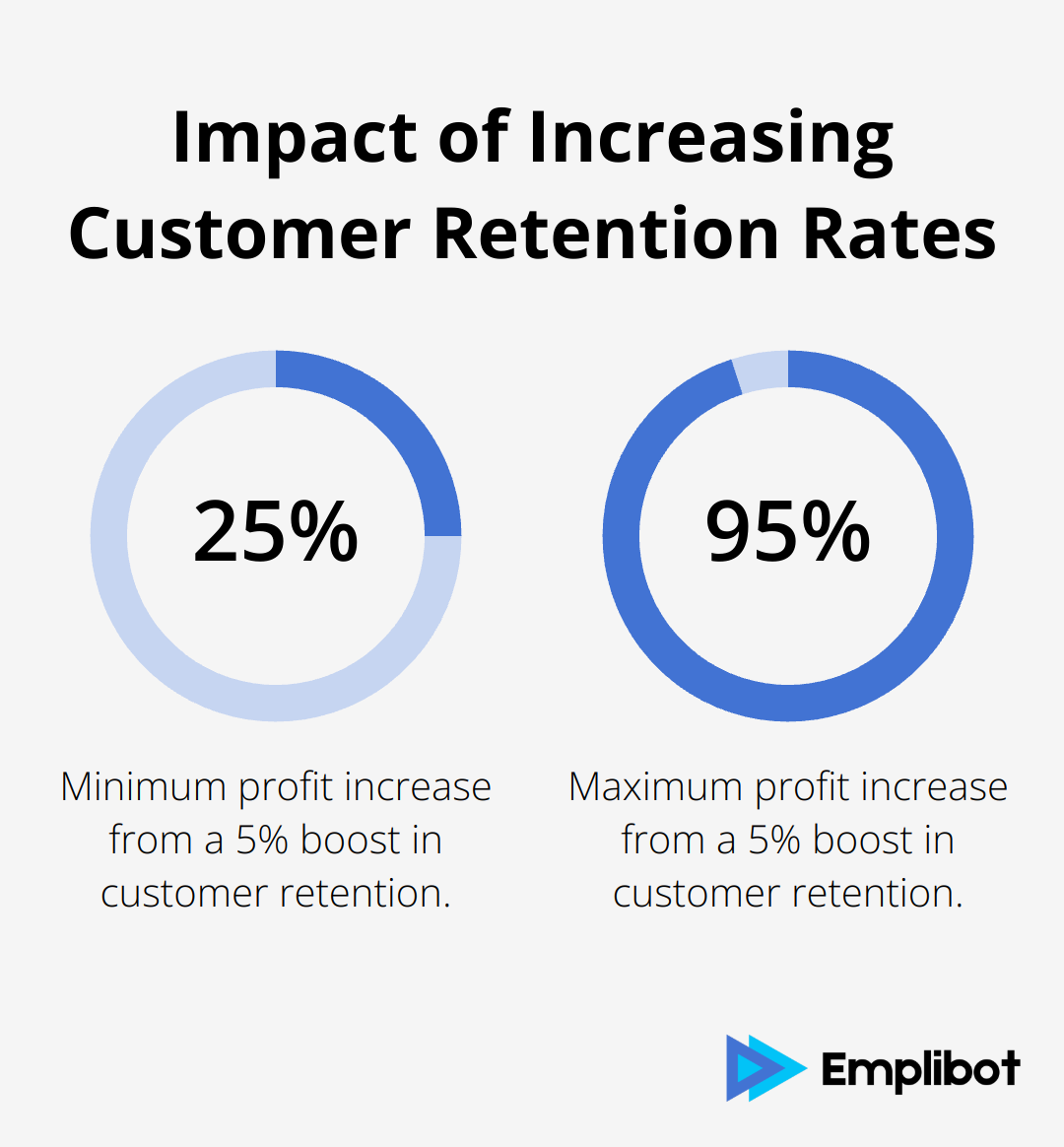At Emplibot, we’ve seen firsthand how a well-structured B2B marketing sales funnel can transform businesses. The right funnel strategy can significantly boost lead generation, conversion rates, and customer retention.
In this comprehensive guide, we’ll break down the stages of the B2B funnel, share effective strategies for each phase, and provide insights on measuring and optimizing your funnel performance.
What Is a B2B Marketing Sales Funnel?
The Strategic Model for Customer Journey
A B2B marketing sales funnel maps out the journey of potential customers from initial awareness to final purchase and beyond. At the top of the funnel is awareness, which means everyone who knows about your company and the products and services you offer. Next comes interest. This strategic model has proven to dramatically improve lead generation and conversion rates for businesses across various industries.
The Necessity of a Well-Structured Funnel
A well-designed B2B funnel is not just beneficial; it’s essential for any business aiming to thrive in today’s competitive landscape. A study by Marketo reveals that 96% of website visitors are not ready to buy when they first land on a site, but may offer their contact information. This statistic highlights the need for a structured approach to guide potential customers towards a purchase decision.
Key Differences: B2B vs B2C Funnels
B2B marketing funnels differ significantly from their B2C counterparts. While B2C purchases often stem from emotion and happen quickly, B2B decisions typically involve multiple stakeholders and longer sales cycles. A Gartner report shows that the average B2B buying group involves 6 to 10 decision makers, underscoring the complexity that necessitates a more nuanced approach to funnel management.
The Five Stages of a B2B Marketing Sales Funnel
While approaches may vary, most effective B2B funnels include these key stages:
- Awareness: Potential customers first learn about your product or service. Content marketing plays a vital role here, with 95% of B2B buyers viewing content as trustworthy when evaluating a company and its offerings.
- Interest: Prospects actively seek information at this stage. Hubspot reports that 47% of B2B buyers consume 3-5 pieces of content before engaging with a sales representative.
- Consideration: Potential customers evaluate your offering against competitors. According to Demand Gen Report, 78% of B2B buyers use case studies when researching purchases.
- Decision: This critical stage is where prospects decide whether to purchase. A study by CSO Insights found that 74% of B2B buyers choose the company that was first to add value and insight.
- Retention: This often-overlooked stage is vital. Bain & Company research indicates that a 5% increase in customer retention rates can boost profits by 25% to 95%.

The Value of Each Stage
The goal of a B2B marketing sales funnel isn’t just to move prospects through stages, but to provide value at every step of their journey. Each stage presents unique opportunities to engage, inform, and persuade potential customers.
As we move forward, we’ll explore effective strategies for each of these funnel stages, helping you optimize your B2B marketing efforts and drive better results. Let’s start by examining tactics for the top of the funnel: awareness and lead generation.
How to Optimize Each Stage of Your B2B Funnel
Awareness: Cast a Wide Net
To capture attention at the top of the funnel, create valuable, educational content. Eighty-seven percent of B2B marketers say content marketing created brand awareness in the last 12 months. Develop a mix of blog posts, whitepapers, and infographics that address your target audience’s pain points.
Use social media platforms where your audience spends time. LinkedIn (used by 97% of B2B marketers for content distribution) stands out as a prime channel. Share your content consistently and engage with your followers to build brand awareness.
Partner with industry influencers. A study by TopRank Marketing found that 63% of marketers believe influencer marketing delivers a higher ROI than traditional advertising.
Nurturing: Build Trust and Qualify Leads
Email marketing remains a powerful tool for lead nurturing. Experian reports that for every $1 spent on email marketing, the average return is $44.25.

Implement a lead scoring system to prioritize your efforts. Companies that use lead scoring see a 77% increase in lead generation ROI over those that don’t (according to Gartner).
Create targeted content for different buyer personas. Personalized calls-to-action convert 202% better than default versions (HubSpot).
Converting: Seal the Deal
As leads move to the bottom of the funnel, demonstrate your unique value proposition. Case studies prove particularly effective here, with 78% of B2B buyers using them when researching purchases (Demand Gen Report).
Offer product demos or free trials. 78% of B2B buyers prefer to use demos when evaluating software purchases (Software Advice).
Don’t underestimate the power of social proof. 91% of consumers read online reviews, and 84% trust them as much as personal recommendations (BrightLocal).
Retention: Turn Customers into Advocates
Post-purchase strategies drive long-term success. Marketing to existing customers is now exceeding that to new ones, according to a report from 2006.
Implement a customer onboarding program. 86% of people say they’d more likely stay loyal to a business that invests in onboarding content that welcomes and educates them after they’ve bought (Wyzowl).
Create a loyalty program. Members of loyalty programs generate 12-18% more revenue for businesses than non-members (Accenture).
Optimizing your B2B funnel requires ongoing effort. Analyze your metrics, gather customer feedback, and adjust your strategies accordingly. These tactics will set you on the path to a more effective B2B marketing funnel. Now, let’s explore how to measure and optimize your funnel performance for even better results.
How to Measure and Optimize Your B2B Sales Funnel
Essential KPIs for Each Funnel Stage
Effective measurement of your B2B sales funnel requires tracking specific Key Performance Indicators (KPIs) at each stage. For the awareness stage, focus on metrics such as website traffic, social media engagement, and content downloads. A whopping chunk (58%) of B2B marketers rate their content strategy as merely “moderately effective.”
In the interest and consideration stages, monitor email open rates, click-through rates, and time spent on your website. HubSpot indicates that the average email open rate for B2B companies is 30.5%, which serves as a useful benchmark.
For the decision stage, track conversion rates, sales qualified leads (SQLs), and average deal size. The Software Advice B2B Demand Generation Benchmark Report found that the average conversion rate from SQL to closed deal is 22%.
Post-purchase, monitor customer retention rates, Net Promoter Score (NPS), and customer lifetime value (CLV). Bain & Company’s research shows that increasing customer retention rates by 5% increases profits by 25% to 95%.

Powerful Tools for Funnel Analysis
Effective gathering and analysis of these metrics require the right tools. Google Analytics stands out as a must-have for tracking website performance and user behavior. For email marketing metrics, platforms like Mailchimp or Constant Contact offer robust analytics.
CRM systems (such as Salesforce or HubSpot) prove invaluable for tracking leads through your funnel. These tools provide a holistic view of your sales process and help identify bottlenecks.
For more advanced analysis, business intelligence tools like Tableau or Power BI can help you visualize your data and uncover deeper insights about your funnel performance.
Continuous Optimization Strategies
Optimization of your B2B sales funnel requires an ongoing process. Start with regular audits of your funnel. Identify where leads drop off and brainstorm ways to improve those stages.
A/B testing serves as a powerful optimization technique. Test different versions of your landing pages, email subject lines, and call-to-action buttons. Even small improvements can lead to significant gains. Wordstream found that businesses with 40+ landing pages generated 12 times more leads than those with 5 or fewer.
Customer feedback provides invaluable insights for optimization. Conduct surveys or interviews with both won and lost customers to understand their journey through your funnel.
Ensure alignment between your sales and marketing teams. MarketingProfs reports that companies with aligned sales and marketing teams are 67% better at closing deals. Regular meetings and shared KPIs can foster this alignment.
Leveraging Advanced Analytics
Advanced analytics can uncover hidden patterns and opportunities in your funnel data. Try predictive analytics to forecast future trends and identify high-value leads. Machine learning algorithms can help segment your audience more effectively and personalize your marketing efforts.
Implement multi-touch attribution models to understand which touchpoints have the most impact on conversions. This insight allows you to allocate your marketing budget more efficiently and focus on the most effective channels.
Final Thoughts
A well-structured B2B marketing sales funnel forms the backbone of successful lead generation and customer acquisition. Businesses can significantly improve their conversion rates and overall marketing effectiveness by understanding and optimizing each funnel stage. The journey from awareness to retention requires a strategic approach, tailored content, and continuous refinement based on data-driven insights.
Several key elements contribute to an effective funnel strategy. Companies must create valuable content that addresses their target audience’s pain points at each stage of the journey. They should leverage technology to track and analyze funnel performance, using tools like CRM systems and analytics platforms. Maintaining alignment between sales and marketing teams ensures a seamless customer experience.
The B2B landscape continues to evolve, with artificial intelligence and machine learning playing an increasingly important role in personalizing customer experiences. At Emplibot, we understand the challenges of managing a comprehensive content marketing strategy. Our automated content creation and distribution platform can help streamline your B2B marketing efforts, ensuring a consistent flow of high-quality content throughout your funnel.

